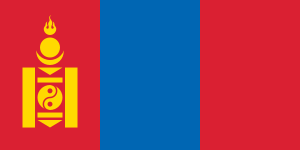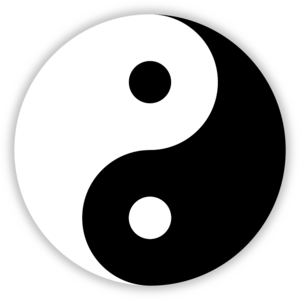Yin and yang facts for kids

The Taijitu (pronounced Tie-jee-too), often called Yin and Yang, is a famous Chinese symbol. It comes from an ancient belief system known as Taoism. This symbol shows that everything in nature has two parts that seem opposite but actually work together.
The traditional Yin and Yang symbol uses two main colors: White for Yang and Black for Yin. Each side also has a small dot of the opposite color. This shows the main idea of dualism: that opposites are connected and can even contain a bit of each other.
Think of examples like light and dark, or male and female. These are opposite ideas, but they need each other to make sense. Other examples include the Sun and Moon, or movement and rest. Yin and Yang can also change into one another, meaning Yang can become Yin over time.
The idea of Yin and Yang also applies to how we live our lives. It suggests we should not have too much or too little of anything. For example, food is important for survival. But eating too much can cause health problems, while eating too little leads to starvation. Finding a balance is key.
Contents
Understanding Yin and Yang
The Yin and Yang symbol helps us understand balance in the world. It shows how different forces work together.
What Yin and Yang Mean
- Yin is often seen as dark, cool, passive, and feminine. Think of the moon, night, or rest.
- Yang is often seen as light, warm, active, and masculine. Think of the sun, day, or movement.
These two forces are always changing and interacting. They are not separate but are two sides of the same coin.
Yin and Yang in Daily Life
The ideas of Yin and Yang can be seen in many parts of our everyday lives.
Health and Well-being
Traditional Chinese Medicine uses Yin and Yang to understand health. If Yin and Yang are out of balance, it can cause illness. For example, sleep and relaxation are considered Yin. Exercise and being active are seen as Yang. A healthy person has a good balance of both.
Relationships with Others
Good relationships also need balance. Giving and receiving are like Yin and Yang. So are being active together and having quiet time alone. Finding this balance helps relationships stay strong.
Food and Seasons
Some foods are thought to be Yin (cooling), while others are Yang (warming). A healthy diet includes both types of food. The seasons also show Yin and Yang. Winter is Yin (cold, dark). Summer is Yang (hot, bright). Spring and Autumn are in-between seasons, showing a mix of both.
Emotions and Feelings
Even our feelings can be understood with Yin and Yang. Joy and excitement are Yang, as they are active and energetic. Calmness and peace are Yin, as they are quiet and still.
Yin and Yang in Science
The idea of two opposite but connected forces can also be seen in Science.
Magnets and Poles
For example, magnets always have two parts: a north pole and a south pole. Both poles are needed for the magnet to work and create a magnetic field. You cannot have one without the other.
Chemistry and Particles
In chemistry, the tiny parts of an atom can be like Yin and Yang. Protons have a positive charge and can be thought of as Yang. Electrons have a negative charge and can be thought of as Yin. They are opposite but work together to form atoms.
See also
 In Spanish: Yin y yang para niños
In Spanish: Yin y yang para niños


